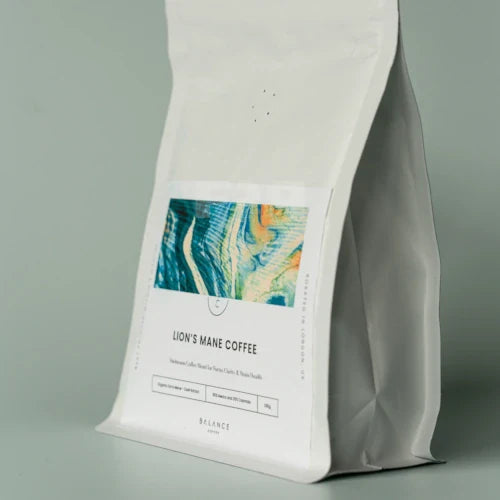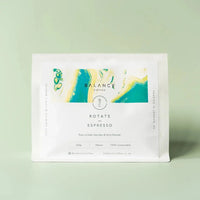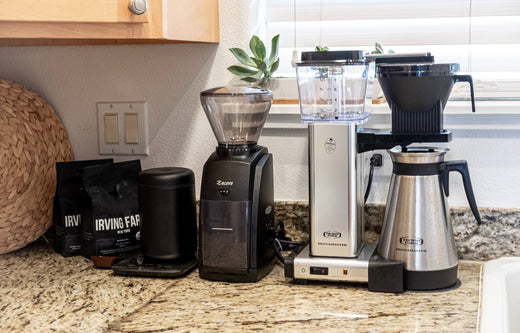Welcome to our coffee tutorial on how to make flat white coffee at home.
If you're anything like me, you absolutely love the ritual of sipping on a perfectly balanced, creamy flat white which pairs beautifully with a rich, flavoursome espresso?
It gives you an immediate warming inside and when coupled with that caffeine boost you need makes for one of the world's best beverages to ever be created (in my opinion).
If you've started buying speciality coffee at home then congratulations. You'll be saving money whilst enjoying fresh coffee every morning.
But if not, I wrote about the best coffee beans in the UK, I suggest you start there to pick what is right for you.
So what's the catch?
Let me guess. You just can't quite make a flat white like your favourite barista makes it?
When you order a flat white from your local cafe, they make it look easy don't they. That classic heart shape, swan pattern, or elegant tulip, artfully placed on top of your creamy coffee as though it was drawn on with a paint brush.
Well what if I told you, with the right information and practice, I can help you make it with a few simple steps?
Now there's no definite promise you'll be doing it to a coffee shops standard, since there are quite a few variables which can affect that. (more on this later in the article).
Nevertheless, you'll definitely improve your results.
I'm probably the perfect case study too. I entered the coffee industry back in 2012 without any prior coffee knowledge.
At that point, I never imagined I'd ever be able to produce latte art either. But after just a few weeks of some expert barista training and a whole lot of practise, I was able to master every coffee drink from the menu.
So I have complete faith that you'll be able to make the perfect flat white coffee, especially if you already know how to make coffee with an espresso machine.
So let's get started.
1. The Definition of a Flat White Coffee
Before we get into the fun stuff and learn how to make it, it's worth me answering the question you're probably wondering.
What is a Flat White?
Quite simply, the flat white is a stronger version of the more commonly known 'latte' coffee drink.
The Flat White first originated back in the 1980's in Australia where local cafe owners referred to this unknown drink.
Although, the naming and ownership of this famous drink is quite contentious. New Zealanders also claim they invented this magical milky drink.
Flat White vs Latte
The closest beverage to the flat white drink is the latte, both pair espresso and milk to create a creamy coffee drink.
So we've established they look kind of similar, but what are the differences and what is a flat white coffee?
Firstly, the flat white recipe uses a smaller sized cup (5-6oz). First, a double espresso is brewed into a pre-heated cup. Next, perfectly textured milk is poured into the coffee, with just the right amount of micro foam on top which creates a small layer.
As a result, the flat white coffee recipe creates a strong, punchy drink which allows the espresso to still cut through the milk.
By contrast, the latte uses a larger cup size of 8oz as a minimum. This means that straight away more dilution occurs compared to the flat white drink. So if you love your coffee with milk stronger, then a flat white is for you. If you prefer your drink to be creamier and milkier, then a latte will be perfect for you.
In essence, the flat white is a concentrated version of the latte, creating a lower coffee to milk ratio.
Furthermore, if you enjoy strong milky coffee, you may want to try a Piccolo or the Cortado since they use even less milk creating extra punch. 
2. The Science
Let's get down to the science behind how to make a flat white shall we?
Let's break down the flat white into two parts.
Espresso Brewing
Firstly, the espresso base of the drink. You can't make an incredibly delicious flat white without first mastering the espresso part of the drink.
To make the perfect perfect flat white a critical component is the quality of espresso. If you have an under extracted espresso shot which tastes sour and unbalanced, the milk won't mask the flavour, it'll highlight it.
Therefore, making sure you focus on mastering the espresso is essential before you dive into the milk aspect and invest time in creating the perfect foam.
Espresso is produced using finely ground coffee and an espresso machine that pushes water through the compressed coffee bed at 9 bars of pressure.
In order to achieve amazing espresso, you'll need to buy a top quality coffee grinder for home. You can read our article covering the best coffee grinders in the UK.
Once you've mastered the espresso, you'll enjoy a perfectly extracted espresso shot, rich in flavour and colour.
Pro tip: If you don't use freshly roasted coffee, you won't obtain that golden brown thick crema on top of your flat white. Instead, the coffee will be lacking structure and vibrancy which notice visually as well taste inside the cup.
Milk Steaming
Now the espresso is dialled in correctly, we can move on to the fun part. Every aspiring baristas dream is to master the milk steaming process so you're pouring latte art on top of every flat white you make.

Now the espresso is dialled in correctly, you can move on to the steaming process.
To nail this, you'll want to use cold milk (or oat milk). The trick is to inject air early on into your jug to create what is known as 'the vortex'.
The vortex is the swirling, circulating motion of the milk when you find the perfect angle and sweet spot for texturising milk.
In other words, the combination of powerful steam pressure from your espresso machine, with some barista knowledge, and you're already half way there.
With some practise, this will become second nature to you, so don't worry too much at the start if you're getting frustrated.
An area to specifically focus on at the beginning is foam consistency, It's easy at the beginning to get carried away with the pouring stage of the drink.
However, master your micro-foam and the hard work will be done for you when it comes to the pouring stage.
3. How to Make a Flat White Coffee
So you've got this far, congratulations. Now we're getting into the nitty gritty so you can start implementing our instructions and learning how to make a flat white at home.
Remember, practise makes perfect.
Flat White Coffee Recipe
- Pull a double espresso into your favourite cup. To make it easier for yourself, choose a coffee cup with a wide diameter. Why?
This will help as you practice because you'll have more space to lower the jug into. It's also far easier to produce coffee patterns.
- Steam the milk to 55–68 °C (no hotter). Why? When you stream milk above 68 °C, you begin to change the flavour of the milk. In the beginning, you can use a thermometer and then as you get more comfortable, you can train your hand to judge the perfect temperature.
- Ensure you create the vortex during the steaming process for beautifully textured milk in the jug.
- When finished, first tap the base of the jug on your kitchen surface to remove any trapped air bubbles.
- Swirl the jug firmly on the surface to re-combine the milk particles. This will give you that glossy, velvety shine you desire.
- Pour in a circular motion whilst pouring to ensure an even base. Then drop the jug into the cup and move your hand to create the latte art on top.
Here's a video guide on how to pour latte art with the Sage Barista Pro. Hopefully you'll find our latte art tutorial useful.
While it, check out my article on how to make espresso coffee at home step by step.
How to Do Latte Art
Everyone loves this part of the experience don't they?
It's the icing on the cake once you've worked hard to learn how to make a latte art properly.
I'm going to share with you a list of the most common patterns on coffee, so you can tackle them based on the difficulty level.
So where do you even start when looking to learn how to make patterns in coffee? Here are my best tips:
1. Ensure you have glossy, velvety micro-foam. It's pretty much essential if you want to master this skill.
2. Pour the milk right away after steaming. This ensures the milk doesn't change consistency which it naturally does after time. Fire your pour quickly for best results.
3. Use a small jug. This will really help with your control levels. A large jug on the other hand, will mean the milk will pour out quickly so you'll lose control.
4. Choose a good milk. Different milks perform differently after steaming. Find the one you like that steams well for best coffee pattern results.
Heart Pattern:
Interestingly so, the heart is the easiest and most common design in coffee art. t looks the most difficult as the shape is very precise, but thankfully, the majority of the shape is formed as the milk naturally forms into the cup in an apple-like shape.

From there, you simply lift up the jug and strikethrough the apple shape which pierces through to create the heart.
Fern Pattern:
The fern coffee art or otherwise known as the coffee leaf design, is one step up from the heart in the difficulty level. So once you've mastered the heart it's the perfect next challenge.
This time, you start by pouring in the rear of the cup to maximise your space for the remainder of the pattern. Once the outer ring begins to form, you need to wiggle left and right whilst progressively moving your hand backwards.
At the end, you'll lift up the jug and strikethrough the pattern to create the leaf effect.
Tulip Pattern:
The tulip is undoubtedly one of the most beautiful coffee designs. Check out the image below, as you can see I created this design inside our sustainable Huskee cup. Everyone loves the tulip design don' they?
Swan Latte Art
The swan is the most difficult out of the list I've compiled today. It requires, a very deep understanding of the milk texture, timing but also a very steady had because of the intricacies of the coffee pattern itself.
4. Practise, Practise, Practise
Mastering the famous flat white can't be done overnight.
You'll need a combination of patience, technique, and tons of practice to produce an excellent barista-level flat white.
Luckily for you, in this article we've covered the core foundations required to make a flat white at home so you can follow our advice to improve your skills.
If you're searching for other ways to upgrade your coffee quality at home, check out our popular blog that covers the best 10 tips on how to transform your coffee at home!
Do you want to learn more about coffee, explore more of our coffee blogs.
If you have some feedback we'd love to hear from you too - simply, leave your comments below and we'll respond


















